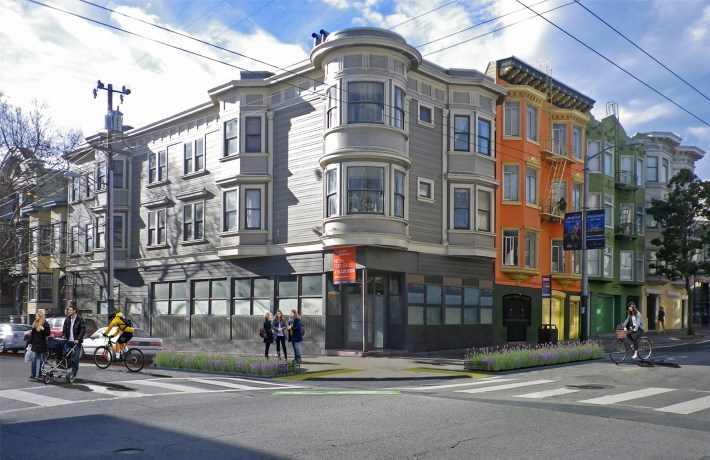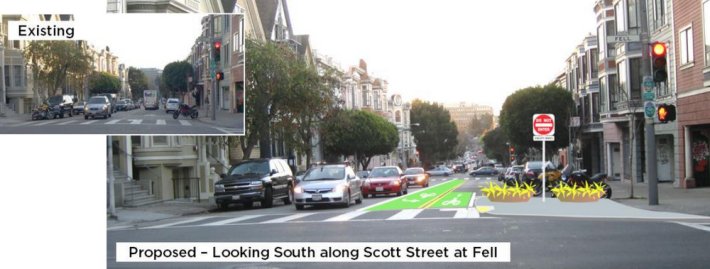The Wiggle is set to become a calmer, safer, and greener route after proposals presented by the SFMTA yesterday, with improvements like raised crosswalks, bulb-outs with greenery, textured pavement, and a traffic diverter at Scott and Fell Streets.
The diverter, which would prevent drivers from entering the block of Scott between Fell and Oak Streets in the southbound direction while allowing bike and foot traffic, is expected to lighten car traffic on Scott and facilitate the left turn into the Fell Street bike lane. Although the SFMTA has installed a protected left-turn signal there, some bike commuters continue to make the short-distance turn against a red light, when drivers have a green light to turn left on to Scott into their path. Under the SFMTA's plan, an "extra-large bulb-out" with planters would physically block drivers from making that left turn.
Leah Shahum, executive director of the SF Bicycle Coalition, called the traffic diverter "a great tool for safer, smarter movement on our streets."
"It's exciting that we're not just thinking of the traditional designs of yesteryear," she said. "It's great to be thinking outside the box."
Concerns voiced by some neighbors at a meeting about traffic diverters on Scott in September seem to have been largely assuaged. The diverter even has support from many Scott residents, according to attendees at yesterday's open house meeting. Although some neighbors on parallel streets remain concerned about drivers using their streets as an alternative, SFMTA planners say they plan to adjust traffic signals to make Divisadero flow more smoothly for motor traffic, including the 24-Divisadero, making it the most attractive option for drivers. "In fact," says an SFMTA FAQ sheet [PDF], "some cross-town traffic on" neighborhood streets such as Steiner, Pierce, and Broderick "may switch to Divisadero as well."
"It seems like there's huge agreement that this neighborhood has so much more potential to be a great walking, biking, living environment," said Shahum. "I think the city's put forward some really strong proposals."

Along the rest of the Wiggle, traffic-calming measures -- for both cars and bicycles -- would include five raised crosswalks. In addition, the hairy intersection of Page and Steiner Streets would see every crosswalk raised, along with "textured pavement." One new measure for the city, aimed particularly at calming bicycle traffic, would be "speed reduction stripes" -- "narrow strips of paint or textured pavement" -- installed on approaches to crosswalks in nine spots.
Bulb-outs, many of which would include "rain gardens," would be installed at corners on the west side of Oak and Scott Streets, the northeast corner of Scott and Haight Streets, the southwest corners of Pierce at Haight and Page, northeast Pierce and Waller, and southwest Waller and Steiner. Those are in addition to the "extra-large" bulb-out at Scott and Fell.

Permeable pavement, which absorbs stormwater and visually narrows the roadway, would also be installed under the parking lanes along the Wiggle's respective blocks of Waller, Pierce from Waller to Page, Page from Pierce to Scott, and Scott from Page to Fell. (That route does deviate from the Wiggle for two blocks because, SFMTA planners say, the loads of Muni buses and delivery trucks that stop on Haight would be too much for permeable pavement.)
Some attendees voiced concern about the traffic signals that would replace stop signs at the Haight intersections with Pierce and Scott, planned separately as part of the Muni Transit Effectiveness Project. The signals would have transit priority (turning green for buses), but it would be a change from the current take-your-turn system, adding wait times for people walking and biking, and possibly encouraging speeding through the intersections to beat the lights.
The Wiggle plans are expected to head to the SFMTA Board of Directors for approval near the end of the year, and construction is scheduled throughout 2016.
"We're hoping that it keeps moving on a track towards actual implementation," said Shahum.





